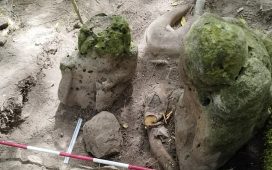Scientists are calling for a new analysis of the Shroud of Turin amid a seemingly growing body of evidence that challenges the idea it’s a fake.
There are also claims that bad data was used in a landmark 1988 UK study which found the shroud was a Medieval forgery and not the cloth Jesus was buried in.
A new review by researchers from France and Italy has revisited those 30-year-old findings and claims to have discovered discrepancies in the data which were not made public and raise doubts about the definitiveness of the results.
Tristan Casabianca, a French independent researcher, who made the find, told DailyMail.com that his findings do not confirm the shroud is older or the burial cloth used to lay Jesus to rest.
But Casabianca – who was an atheist until he began investigating the shroud 20 years ago – said those factors could not be ruled out ‘without a re-analysis.’

The research in question is a 1988 study that conducted radiocarbon dating on a piece of the shroud. Pictured are the sample containers that held strips of the cloth

Graphic designer Otangelo Grasso created a progression of what Jesus may have looked like based on the shroud image
The 1988 study used a technique known as carbon dating to determine the age of the controversial Shroud of Turin.
The team determined with ’95 percent confidence’ the relic was manufactured sometime between 1260 and 1390 AD, long after the time of Christ’s resurrection.
The conclusion was reached after analyses performed on a corner of the ancient fabric by three different labs – at the universities of Arizona, Zürich and Oxford.
But after obtaining the raw data, Casabianca found the results varied by decades.
One of Zürich’s estimates in the Nature study said the cloth was up to 733 years old, but 595 years in the raw data.
Oxford’s shroud sample was between 730 and 795 years old, but the raw data featured estimates that were off by up to 55 years.
Arizona’s linen was between 591 and 701 years old, with the raw data showing a difference of up to 59 years.
Even though that would still places the cloth in the Middle Ages, hundreds of years after Jesus, Casabianca said it raises doubts.
He continued to explained that ‘the lack of precision seriously affects the reliability of the 95 percent,’ suggesting it was no more than 41 percent.
Anything lower than 60 percent suggests that there is a lot of disagreement or inconsistency among the results, according to the 2019 study published in Archaeometry.
‘We can say with confidence that the 1988 radiocarbon dating process led to a failure,’ said Casabianca, who is an independent researcher in France.
‘It was supposed to close a book, and it has only opened a new chapter. This failure could have been avoided with a better protocol.’

The raw data obtained by Casabianca showed it varied by decades than what was published in the Nature study. The red are changes made by the laboratories between their raw radiocarbon dates and the radiocarbon dates mentioned in the Nature article

The Shroud of Turin is a 14-foot-long piece of linen featuring a faint image of the front and back of a man who Christians believe to be Jesus

The 1988 research was conducted in three laboratories: The University of Arizona, Zürich in Switzerland and Oxford University in the UK. Each lab received a strip from the original piece cut, which were then reduced to smaller sizes for the research
But Dr AJ Timothy Jull, who worked on the 1988 analysis, told DailyMail.com that even if the teams did re-run the analysis, ‘The results would be the same, but the data would be less scattered.’
Dr Jull was part of the team at the University of Arizona.
‘Zürich was close to ours, but Oxford was a bit different,’ Dr Jull said.
‘But that does not change the results. Others use this argument to say there is something wrong with the measurements, Casabianca tries to do this.’
The Shroud of Turin is a 14-foot-long piece of linen featuring a faint image of the front and back of a man who Christians believe to be Jesus.
The cloth was first presented to the public in the 1350s when it was exhibited in the small collegiate church in Lirey, a village in northern France.
Christians believe those wounds were miraculously imprinted on the burial shroud after Jesus was resurrected from the dead, scorched into the fibers by a burst of energy when he came back to life.
Some believe it to be a Medieval fake, which Dr Jull and his team determined in the 1980s.

The piece was cut from the bottom corner on the back of the shroud, which experts said was not mended in the Middle Ages

However, a research involved with the 1988 study said that the radiocarbon dating of the shroud was done correctly

The cloth was first presented to the public in the 1350s when it was exhibited in the small collegiate church in Lirey, a village in northern France
The 1988 study saw scientists take a 10 mm by 70 mm piece of the shroud from the corner, which was cut into smaller pieces and distributed to the different labs.
Co-author Emanuela Marinelli, an independent researcher in Italy, told DailyMail.com: ‘The sample was not representative of the full cloth because it is different [from one corner from another].
‘The [1988] study found dating was more or less 150 years, so it is impossible to say the age of the entire 14-foot cloth.
‘But for us, it was the statistical analysis that is the reason to reject to carbon dating.’
This technique estimates the age of organic materials based on the amount of radioactive isotope of carbon in them.
The results were collected and collated by London’s British Museum, which held on to the raw data until Casabianca and his team issued a legal request under the Freedom of Information Act to obtain the raw information for the first time.
‘I received a reply from the British Museum with more than 200 pages of documents,’ Casabianca said.
‘Our access to the documentation kept in the archives of the British Museum showed that the statistical analysis is supported by the documentation.
‘In it, we find that the samples were contaminated (including cotton and rogue fibers). This suggests that the sampling was suboptimal, to say the least.’
Dr Jull told DailyMail.com that he conducted another in 2010 to characterize the shroud samples, finding ‘odd bits of cotton.’









